22 Galapagos Hawk Facts: Diet, Range, Size, Population… (Buteo galapagoensis)
In this guide, you’ll learn 22 facts about the Galapagos hawk. They include diet, range, size, endangered status, mating habits and more. Curious about which islands the Galapagos hawks live on? And if they are hard to photograph? I cover all this and more, plus photos and up-close videos.
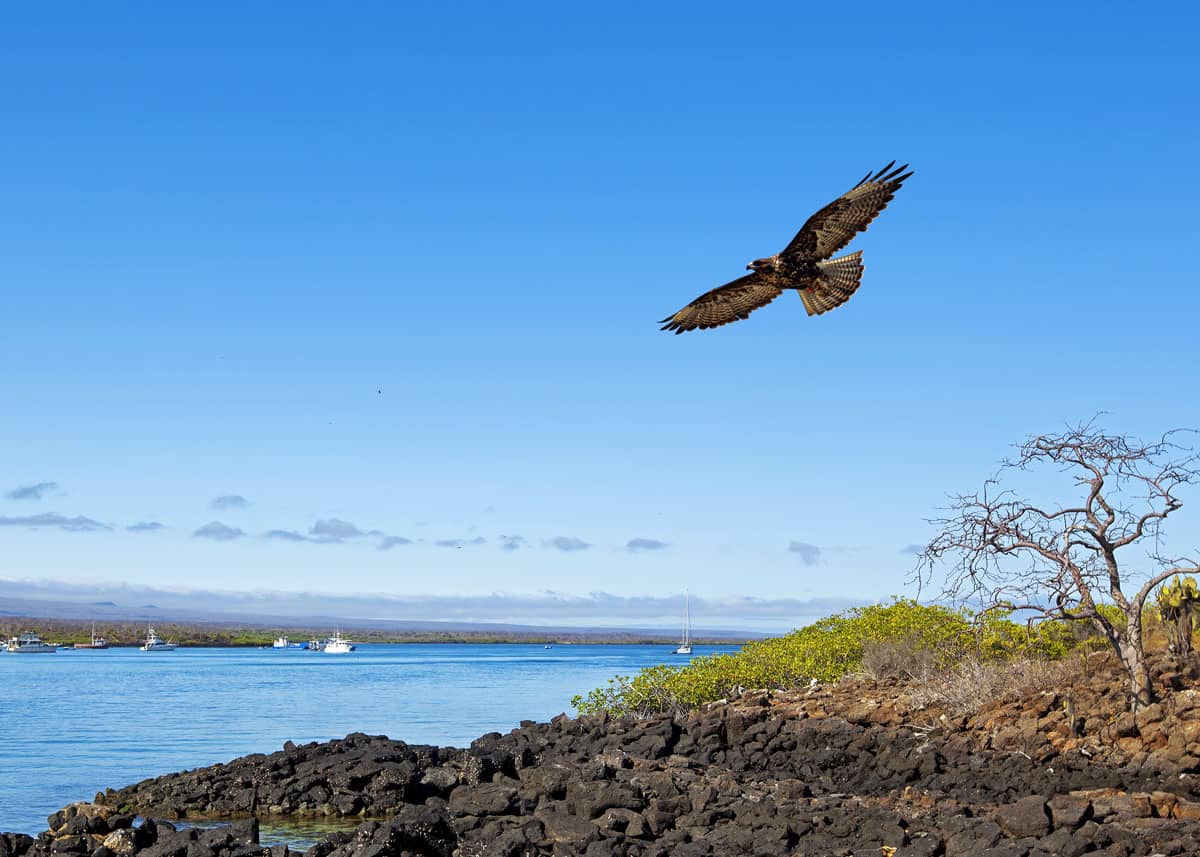
Travel tip: If you’re traveling to the Galapagos, you should bring a camera with a good zoom and a decent pair of binoculars. This will increase the odds of spotting and shooting a Galapagos hawk in the wild.
Travelers Guide to the Galapagos Hawk
The Galapagos Islands are home to many unique birds and animals including one of the world’s rarest raptors, the Galapagos hawk.
Not only is this hawk the largest land bird and top predator on the Galapagos archipelago, but it’s also the only diurnal raptor on the islands, meaning it hunts and feeds during the day.
Want to learn more Galapagos hawk facts? Read on.
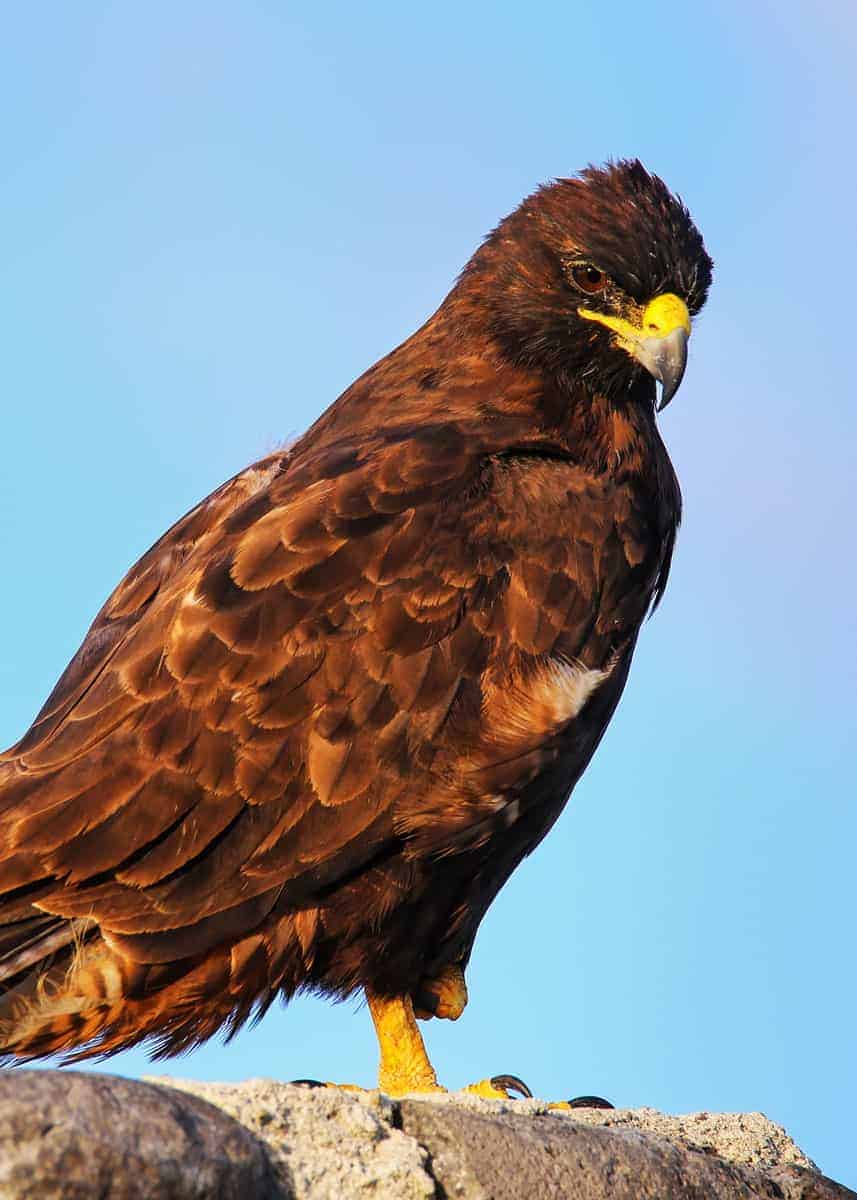
Galapagos Hawk Overview
- Latin Name: Buteo galapagoensis
- Range: Galapagos Islands
- Population Status: Estimated 270-330 individuals
- Height: 18 to 23 inches (45 to 58 cm)
- Weight: 1.5 to 2 pounds (650 to 850 g)
- Wingspan: 46 to 55 inches (116 to 140 cm)
- Diet: Insects, small reptiles, rodents, birds, eggs, and carrion
- Notable Features: Top predator and only diurnal bird of prey in Galapagos Islands
- Where it lives in Ecuador/Galapagos: The islands of Marchena, Santiago, Española, Santa Fe, Isabela, Fernandina, Pinta, and Pinzón.
1. Where does the Galapagos hawk live?
Endemic to the Galapagos Islands, the Galapagos hawk is found living on the islands of Marchena, Santiago, Española, Santa Fe, Isabela, Fernandina, Pinta, Pinzón, Charles, Indefatigable, Duncan, and Chatham.
Scientists say these hawks have been living in the Galapagos Islands for 300,000 years.
They once lived on all the islands of the Galapagos archipelago, but humans and introduced plants and animals reduced their food supply, causing them to go extinct on the islands of Baltra, Seymour, Daphne, San Cristobal, and Floreana.
2. What is the habitat of the Galapagos hawk?
The Galapagos hawk is not picky about its habitat. It can be found in all the different habitats of the Galapagos Islands, from deciduous forest to lava fields and mountain peaks to the shoreline.
3. Where do Galapagos hawks nest?
Galapagos hawks like to nest in prominent areas where they have a good view of their territory. Their nests have been found in low tree branches, on rocky outcrops, lava ledges, and even on the ground.
A few other interesting Galapagos hawk facts about their nesting habits include how they build and maintain their nests. They often use the same nests in consecutive breeding seasons year after year, lining them with sticks, grass, leaves and bark.
Because the hawks continuously add fresh twigs and other materials throughout the nesting period, their nests often grow to large sizes, some up to four feet wide (1.22 m).
Parent hawks usually stay close to their nesting site but will abandon the nest if it’s disturbed by humans.
4. What does the Galapagos hawk look like?
- Similar in size and shape to the red-tailed hawk and the Swainson’s hawk of North America, the adult Galapagos hawk is recognized by its ashy brownish-black plumage, broad wings and a wide tail that is barred with white.
- Rufous feathers line the edges of the hawk’s flanks and belly.
- Adults also have yellow legs and feet, strong talons, a hooked bill with a yellow cere, and brown eyes that are known for exceptional vision.
- Juveniles are a paler brown with buff underparts that are mottled with dark brown specks. Their eyes and feet are lighter in color, and their cere is more grayish-green.
- Both sexes feature similar plumage, but the female is larger than the male.
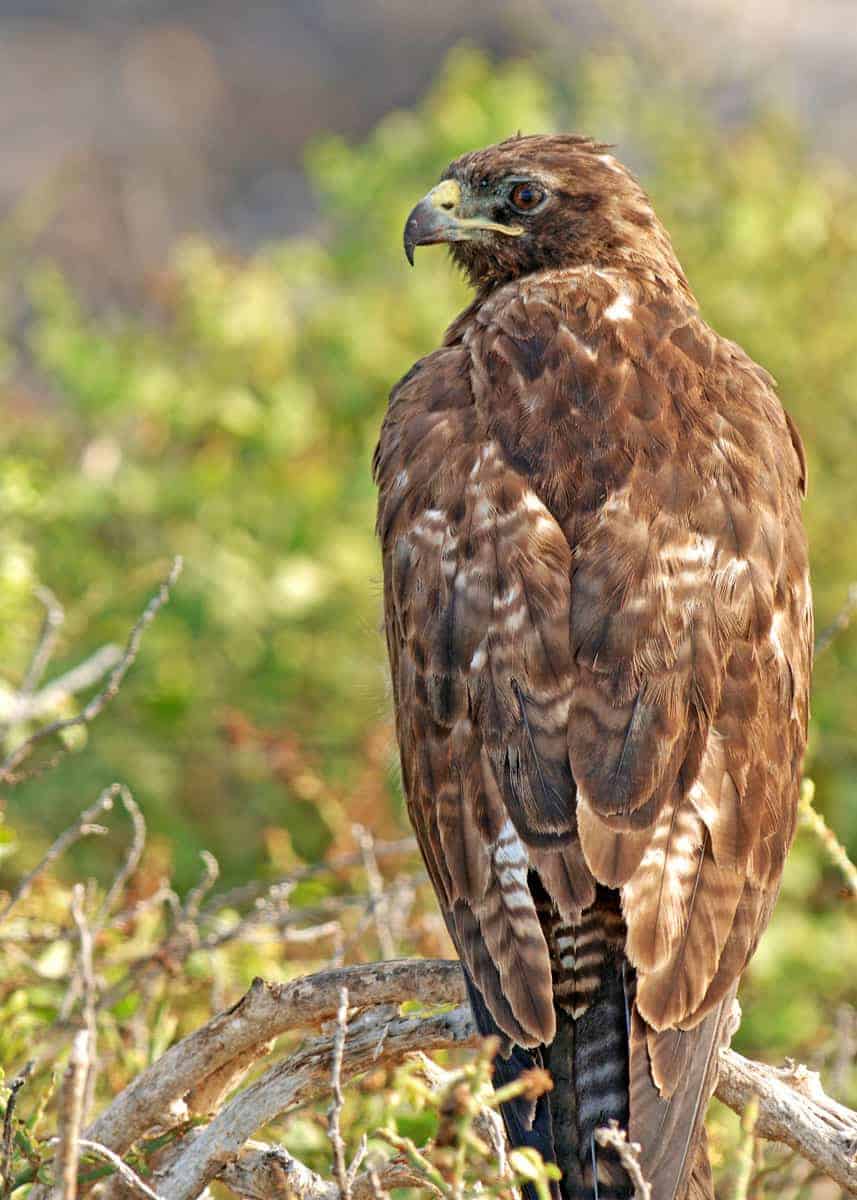
(When you’re out looking for the Galapagos hawk don’t forget to bring a good sun hat – the sun is stronger than you might expect. Here are some of our favorites.)
5. How tall is a Galapagos hawk?
The size of Galapagos hawks vary from island to island, but their height generally ranges from 18 to 23 inches (45 to 58 cm).
6. How much does a Galapagos hawk weigh?
The average weight among Galapagos hawks ranges from approximately 1 ½ to 2 pounds (650 to 850 g).
The largest of these hawks are found on Española Island and can weigh up to 3.5 pounds (1.6 kg).
7. What is the Galapagos hawk’s wingspan?
The wingspan of the average adult Galapagos hawk extends nearly 4 feet (120 cm) wide.
8. Are Galapagos hawks friendly? Aggressive?
Like much of the wildlife living on the Galapagos Islands, the Galapagos hawk shows little to no fear of humans. They’ve been known to scavenge around human camps for food scraps. Field researchers have even documented being able to pet these hawks.
Illustrating their fearlessness, here’s what Charles Darwin had to say.
“A gun is here almost superfluous; for with the muzzle I pushed a hawk out of the branch of a tree…” ~ Charles Darwin, 1845
But, when the hawks have babies present, it’s a different story altogether. They will put up a territorial defense to protect their young from any perceived threat.
9. How long do Galapagos hawks live?
Unknown. It’s still not known for certain exactly how long Galapagos hawks live. More field research needs to be done to determine this fact, but just for a comparison, the red-tailed hawk of North America lives up to 25 years.
Since the Galapagos hawk is similar in size and shape to the red-tailed hawk, this might give you a rough idea of the Galapagos hawk’s life expectancy.
10. What eats a Galapagos hawk? Predators and Threats
The Galapagos hawk is a natural top predator, meaning it’s at the top of the food chain.
No other animal hunts and eats this hawk, but its population numbers have been reduced due to the introduction of cats, dogs, and goats which compete for the same food.
This mighty hawk once lived on all the islands in the Galapagos archipelago but now has gone extinct on the islands of Baltra, Daphne, San Cristobal, and Seymour.
Thankfully, the Galapagos hawk is protected by the Ecuadorian government against hunting and trade. Nearly all of the land where this hawk currently lives is protected by the Galapagos National Park. Researchers believe that the Galapagos hawk population is slowly improving and will recover because of conservation efforts.
11. Is the Galapagos hawk endangered?
No. According to the IUCN Red List, this hawk is not endangered but vulnerable due to its small population of approximately 270 to 330 individuals.
12. What do Galapagos hawks eat?
Much of their diet consists of insects such as locusts and giant centipedes as well as rodents, birds, snakes, lava lizards, small iguanas, and the eggs and hatchlings of sea turtles and other birds.
They’re also known to feed on carrion and follow fishing boats to snatch discarded scraps. As the only diurnal raptors in the Galapagos Islands, these hawks hunt and feed during the daytime.
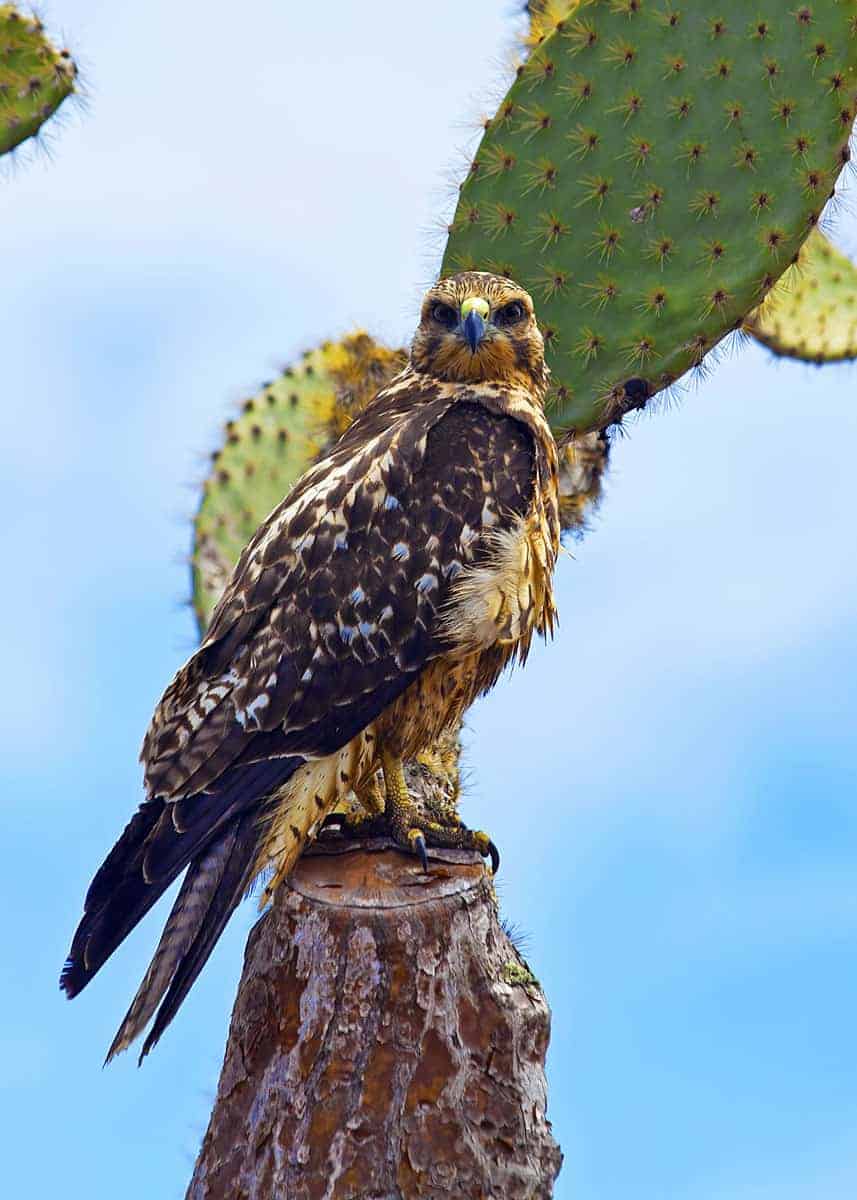
13. How do Galapagos hawks hunt?
As skilled hunters, the Galapagos hawks know that working as a team is to their advantage. They often hunt in small groups of two or three in which a female is usually the dominant leader.
They often hunt by soaring high across the sky, using their keen eyesight to spot prey. Other times, they may perch in a high tree branch or lava ledge while surveying the area.
When one of the hawks locates a food source, it signals to the others. The dominant female feeds first while the others patiently wait on her to be filled before taking their turn.
Here’s a glimpse of their hunting skills.
14. What is the Galapagos hawk’s Latin name?
- Latin Name: Buteo galapagoensis
- Class: Aves
- Order: Accipitriformes
- Family: Accipitridae
- Subfamily: Accipitrinae
- Genus: Buteo
- Species: B. galapagoensis
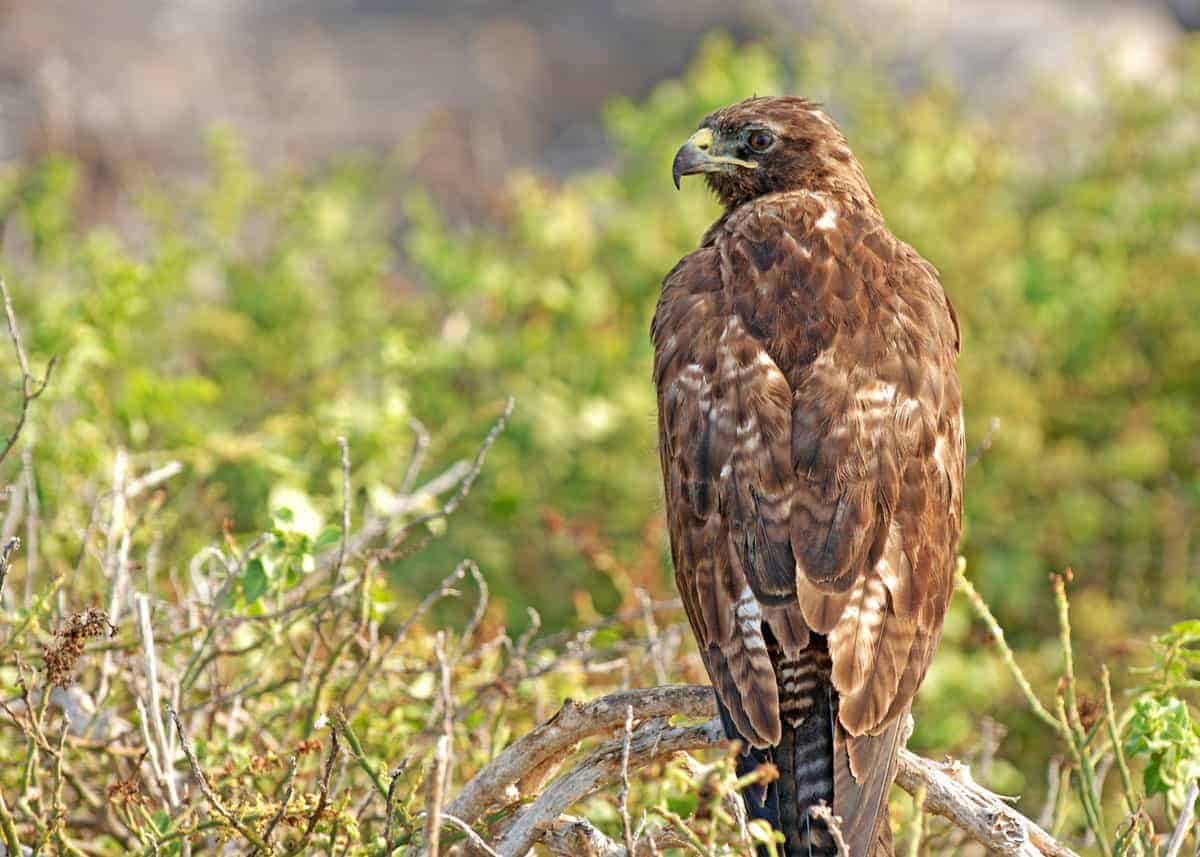
15. Do Galapagos hawks mate for life?
No, Galapagos hawks don’t mate for life.
They have an unusual system of breeding known as cooperative polyandry. In this case, a female will mate with several males (sometimes up to seven) during one breeding period. After the female lays the eggs, all the males will pitch in and help her raise the young. They do this by taking turns with incubating the eggs and feeding the chicks.
16. At what age do Galapagos hawks lay eggs?
Galapagos hawks begin to lay eggs when they are sexually mature, which is around three years of age.
17. How often do Galapagos hawks lay eggs?
It’s not known how often Galapagos hawks lay eggs because they may breed multiple times a year.
These hawks don’t have a seasonal mating period because there are no significant temperature changes on the Galapagos Islands due to being located so near the equator.
18. How many eggs does the Galapagos hawk lay? What do they look like?
Galapagos hawks lay between one and three eggs per clutch. The eggs are white with brown spots and must be incubated about 38 days. Most of the time, only one chick survives from each clutch, fledgling after about 50 or 60 days after hatching.
19. What is the Galapagos hawk’s call?
When in flight, the call of the Galapagos hawk rings out in abrupt screams of “keer-kwee.”
During the mating season, the hawk makes a “kilp, kilp, kilp” call. At other times, it occasionally makes a rapid “cher, cher, cher” sound.
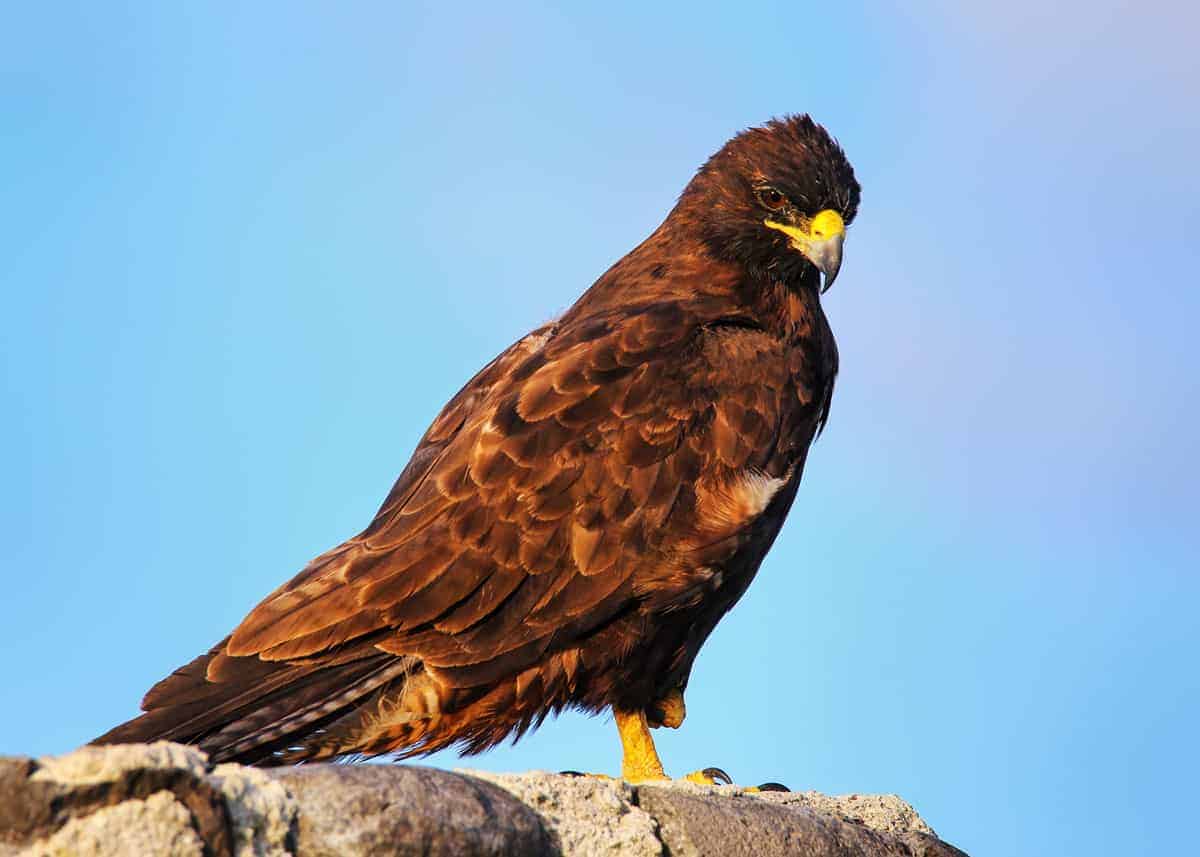
20. Are Galapagos hawks loud?
Yes, Galapagos hawks can be loud. When flying, they pierce the air with their series of screams. But, during mating season, they tone it down a bit and make their calls a little softer and sweeter.
21. Do Galapagos hawks carry disease?
Some Galapagos hawks have diseases caused by lice and parasites as well as bacterial diseases like salmonella and viruses like Avipoxvirus.
Scientists know that the Culex mosquito is present in the Galapagos Islands, which is known to cause avian malaria, but it’s not certain if any of the hawks have become infected with this bird disease.
A collaborating team of various organizations continuously work together to test all the birds in the Galapagos Islands for diseases so that they can prevent the spread of pathogens. Some of these research organizations include the USGS National Wildlife Health Center, the Galapagos National Park, the Charles Darwin Research Station, and the St. Louis Zoo.
The Galapagos hawk is particularly tested because it’s at the top of the food chain. Researchers know that if there are any bird diseases present on the islands, then this hawk would most likely be exposed to them.
So far, no endemic bird species on the islands have gone extinct.
22. Where can I see the Galapagos hawk?
Galapagos hawks are not afraid of humans, so they don’t really hide from people. However, you’re most likely to see them flying in the sky on the Galapagos Islands of Isabela, Santiago, Española, Fernandina, Bartolomé, and South Plaza Islands.
You probably aren’t likely to see these hawks in populated areas because food sources aren’t plentiful enough for them.
If you go on a wildlife tour or cruise to the Galapagos Islands, your guide(s) may take you to places where the Galapagos hawks are most often seen.
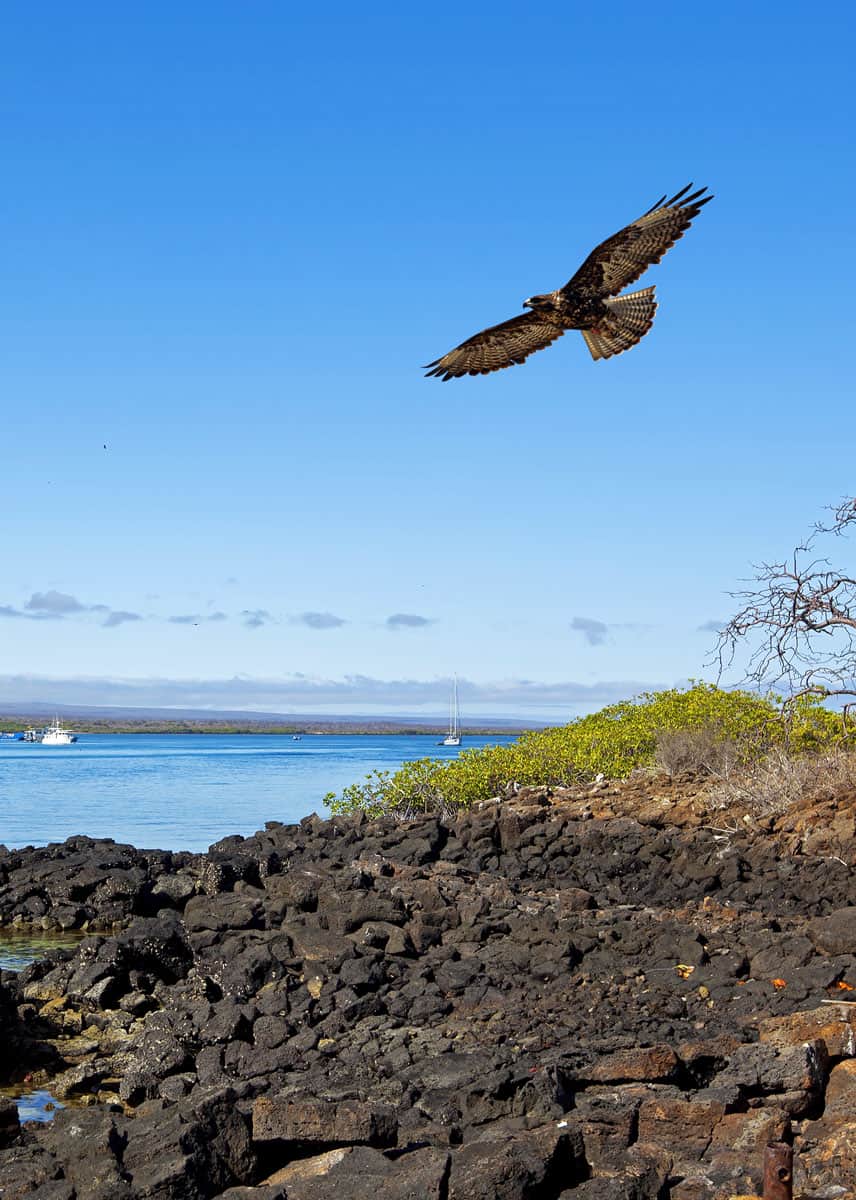
Your Turn
As you can see from these Galapagos hawk facts, this hawk is a special bird. Have you ever been to the Galapagos Islands and seen this hawk in person? Let us know about your experience in the comments.






